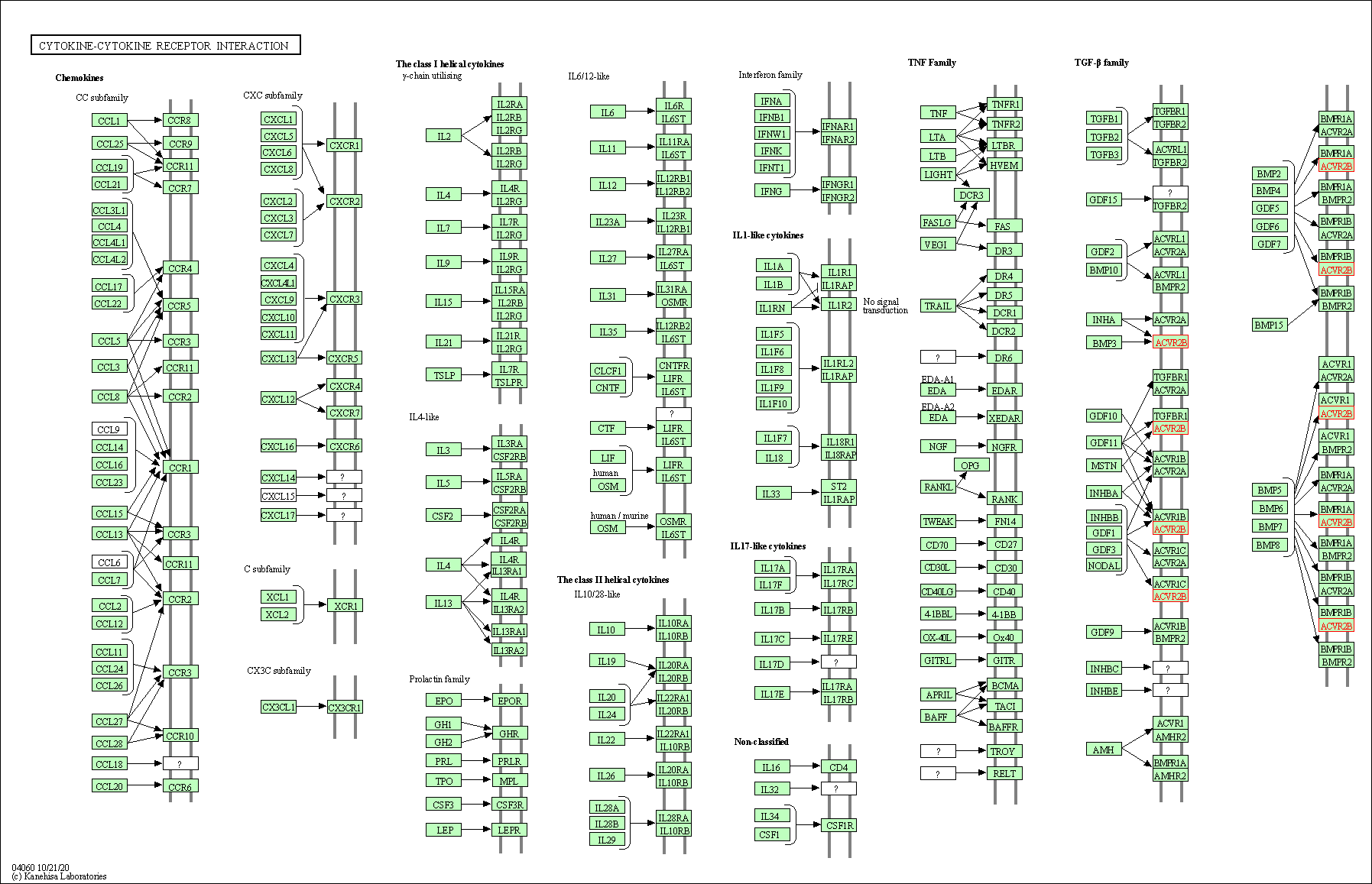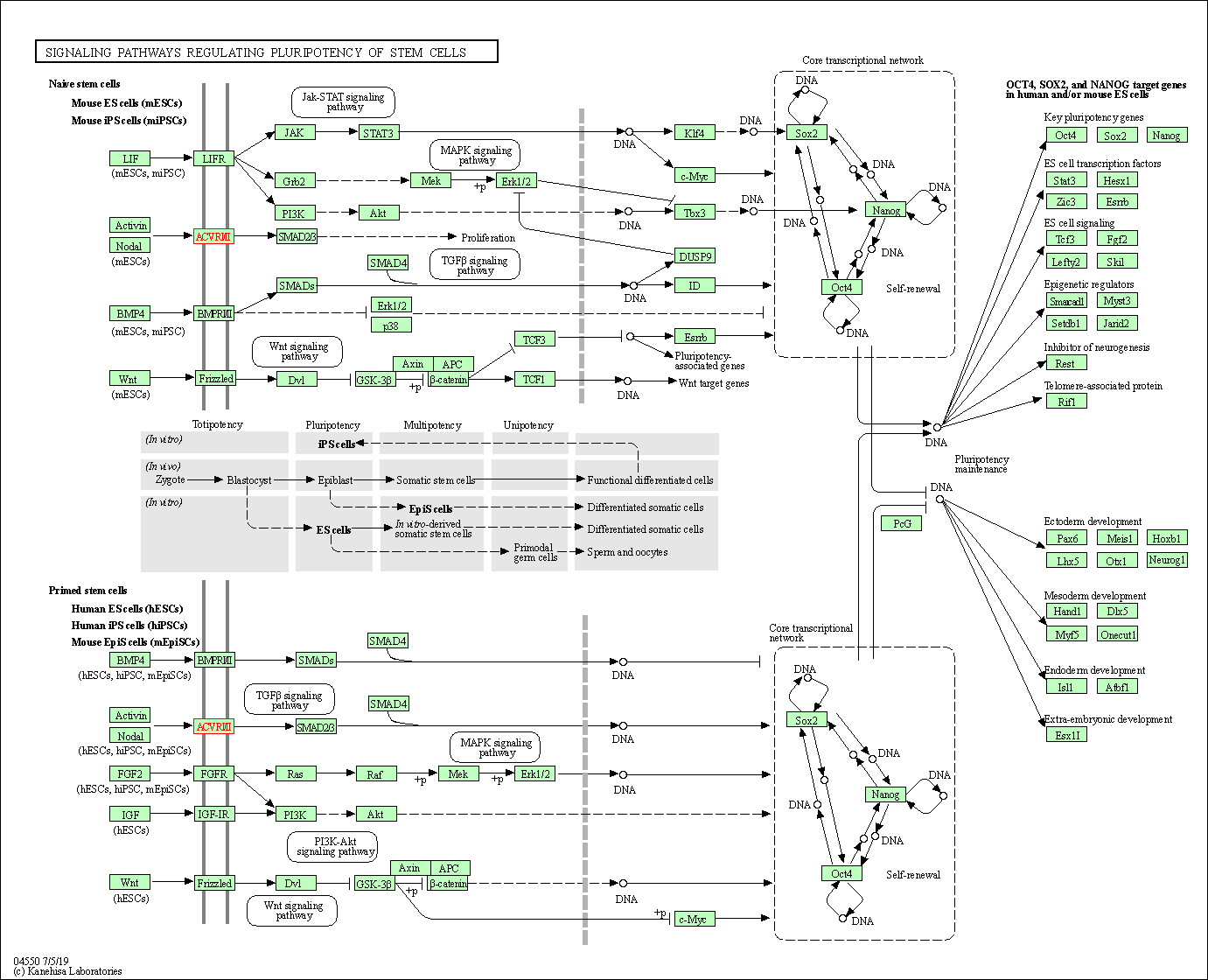Target Information
| Target General Information | Top | |||||
|---|---|---|---|---|---|---|
| Target ID |
T80338
(Former ID: TTDI02445)
|
|||||
| Target Name |
Activin receptor type IIB (ACVR2B)
|
|||||
| Synonyms |
Activin receptor type2B; Activin receptor type-2B; ACTRIIB; ACTR-IIB
Click to Show/Hide
|
|||||
| Gene Name |
ACVR2B
|
|||||
| Target Type |
Literature-reported target
|
[1] | ||||
| Disease | [+] 1 Target-related Diseases | + | ||||
| 1 | Nervous system paraneoplastic/autoimmune disorder [ICD-11: 8E4A] | |||||
| Function |
Transduces the activin signal from the cell surface to the cytoplasm and is thus regulating many physiological and pathological processes including neuronal differentiation and neuronal survival, hair follicle development and cycling, FSH production by the pituitary gland, wound healing, extracellular matrix production, immunosuppression and carcinogenesis. Activin is also thought to have a paracrine or autocrine role in follicular development in the ovary. Within the receptor complex, the type-2 receptors act as a primary activin receptors (binds activin-A/INHBA, activin-B/INHBB as well as inhibin-A/INHA-INHBA). The type-1 receptors like ACVR1B act as downstream transducers of activin signals. Activin binds to type-2 receptor at the plasma membrane and activates its serine-threonine kinase. The activated receptor type-2 then phosphorylates and activates the type-1 receptor. Once activated, the type-1 receptor binds and phosphorylates the SMAD proteins SMAD2 and SMAD3, on serine residues of the C-terminal tail. Soon after their association with the activin receptor and subsequent phosphorylation, SMAD2 and SMAD3 are released into the cytoplasm where they interact with the common partner SMAD4. This SMAD complex translocates into the nucleus where it mediates activin-induced transcription. Inhibitory SMAD7, which is recruited to ACVR1B through FKBP1A, can prevent the association of SMAD2 and SMAD3 with the activin receptor complex, thereby blocking the activin signal. Activin signal transduction is also antagonized by the binding to the receptor of inhibin-B via the IGSF1 inhibin coreceptor. Transmembrane serine/threonine kinase activin type-2 receptor forming an activin receptor complex with activin type-1 serine/threonine kinase receptors (ACVR1, ACVR1B or ACVR1c).
Click to Show/Hide
|
|||||
| BioChemical Class |
Kinase
|
|||||
| UniProt ID | ||||||
| EC Number |
EC 2.7.11.30
|
|||||
| Sequence |
MTAPWVALALLWGSLCAGSGRGEAETRECIYYNANWELERTNQSGLERCEGEQDKRLHCY
ASWRNSSGTIELVKKGCWLDDFNCYDRQECVATEENPQVYFCCCEGNFCNERFTHLPEAG GPEVTYEPPPTAPTLLTVLAYSLLPIGGLSLIVLLAFWMYRHRKPPYGHVDIHEDPGPPP PSPLVGLKPLQLLEIKARGRFGCVWKAQLMNDFVAVKIFPLQDKQSWQSEREIFSTPGMK HENLLQFIAAEKRGSNLEVELWLITAFHDKGSLTDYLKGNIITWNELCHVAETMSRGLSY LHEDVPWCRGEGHKPSIAHRDFKSKNVLLKSDLTAVLADFGLAVRFEPGKPPGDTHGQVG TRRYMAPEVLEGAINFQRDAFLRIDMYAMGLVLWELVSRCKAADGPVDEYMLPFEEEIGQ HPSLEELQEVVVHKKMRPTIKDHWLKHPGLAQLCVTIEECWDHDAEARLSAGCVEERVSL IRRSVNGTTSDCLVSLVTSVTNVDLPPKESSI Click to Show/Hide
|
|||||
| 3D Structure | Click to Show 3D Structure of This Target | AlphaFold | ||||
| Cell-based Target Expression Variations | Top | |||||
|---|---|---|---|---|---|---|
| Cell-based Target Expression Variations | ||||||
| Drug Binding Sites of Target | Top | |||||
|---|---|---|---|---|---|---|
| Ligand Name: Adenine | Ligand Info | |||||
| Structure Description | Crystal structure of Activin receptor type II kinase domain from human | PDB:2QLU | ||||
| Method | X-ray diffraction | Resolution | 2.00 Å | Mutation | No | [2] |
| PDB Sequence |
GSLQLLEIKA
197 RGRFGCVWKA207 QLMNDFVAVK217 IFPLQDKQSW227 QSEREIFSTP237 GMKHENLLQF 247 IAAEKRGSNL257 EVELWLITAF267 HDKGSLTDYL277 KGNIITWNEL287 CHVAETMSRG 297 LSYLHEDVPW307 CRGEGHKPSI317 AHRDFKSKNV327 LLKSDLTAVL337 ADFGLAVRFE 347 PGKPPGDTHG357 QVGTRRYMAP367 EVLEGAINFQ377 RDAFLRIDMY387 AMGLVLWELV 397 SRCKAADGPV407 DEYMLPFEEE417 IGQHPSLEEL427 QEVVVHKKMR437 PTIKDHWLKH 447 PGLAQLCVTI457 EECWDHDAEA467 RLSAGCVEER477 VSLIRRS
|
|||||
|
|
||||||
| Click to View More Binding Site Information of This Target with Different Ligands | ||||||
| Different Human System Profiles of Target | Top |
|---|---|
|
Human Similarity Proteins
of target is determined by comparing the sequence similarity of all human proteins with the target based on BLAST. The similarity proteins for a target are defined as the proteins with E-value < 0.005 and outside the protein families of the target.
A target that has fewer human similarity proteins outside its family is commonly regarded to possess a greater capacity to avoid undesired interactions and thus increase the possibility of finding successful drugs
(Brief Bioinform, 21: 649-662, 2020).
Human Pathway Affiliation
of target is determined by the life-essential pathways provided on KEGG database. The target-affiliated pathways were defined based on the following two criteria (a) the pathways of the studied target should be life-essential for both healthy individuals and patients, and (b) the studied target should occupy an upstream position in the pathways and therefore had the ability to regulate biological function.
Targets involved in a fewer pathways have greater likelihood to be successfully developed, while those associated with more human pathways increase the chance of undesirable interferences with other human processes
(Pharmacol Rev, 58: 259-279, 2006).
Biological Network Descriptors
of target is determined based on a human protein-protein interactions (PPI) network consisting of 9,309 proteins and 52,713 PPIs, which were with a high confidence score of ≥ 0.95 collected from STRING database.
The network properties of targets based on protein-protein interactions (PPIs) have been widely adopted for the assessment of target’s druggability. Proteins with high node degree tend to have a high impact on network function through multiple interactions, while proteins with high betweenness centrality are regarded to be central for communication in interaction networks and regulate the flow of signaling information
(Front Pharmacol, 9, 1245, 2018;
Curr Opin Struct Biol. 44:134-142, 2017).
Human Similarity Proteins
Human Pathway Affiliation
Biological Network Descriptors
|
|
| KEGG Pathway | Pathway ID | Affiliated Target | Pathway Map |
|---|---|---|---|
| Cytokine-cytokine receptor interaction | hsa04060 | Affiliated Target |

|
| Class: Environmental Information Processing => Signaling molecules and interaction | Pathway Hierarchy | ||
| TGF-beta signaling pathway | hsa04350 | Affiliated Target |

|
| Class: Environmental Information Processing => Signal transduction | Pathway Hierarchy | ||
| Signaling pathways regulating pluripotency of stem cells | hsa04550 | Affiliated Target |

|
| Class: Cellular Processes => Cellular community - eukaryotes | Pathway Hierarchy | ||
| Degree | 21 | Degree centrality | 2.26E-03 | Betweenness centrality | 3.65E-04 |
|---|---|---|---|---|---|
| Closeness centrality | 2.19E-01 | Radiality | 1.39E+01 | Clustering coefficient | 2.62E-01 |
| Neighborhood connectivity | 2.38E+01 | Topological coefficient | 1.30E-01 | Eccentricity | 12 |
| Download | Click to Download the Full PPI Network of This Target | ||||
| Chemical Structure based Activity Landscape of Target | Top |
|---|---|
| Target Regulators | Top | |||||
|---|---|---|---|---|---|---|
| Target-regulating microRNAs | ||||||
| Target-interacting Proteins | ||||||
| Target Affiliated Biological Pathways | Top | |||||
|---|---|---|---|---|---|---|
| KEGG Pathway | [+] 3 KEGG Pathways | + | ||||
| 1 | Cytokine-cytokine receptor interaction | |||||
| 2 | TGF-beta signaling pathway | |||||
| 3 | Signaling pathways regulating pluripotency of stem cells | |||||
| Panther Pathway | [+] 1 Panther Pathways | + | ||||
| 1 | TGF-beta signaling pathway | |||||
| PID Pathway | [+] 1 PID Pathways | + | ||||
| 1 | ALK1 signaling events | |||||
| Reactome | [+] 1 Reactome Pathways | + | ||||
| 1 | Regulation of signaling by NODAL | |||||
| WikiPathways | [+] 4 WikiPathways | + | ||||
| 1 | Mesodermal Commitment Pathway | |||||
| 2 | Signaling by Activin | |||||
| 3 | Signaling by BMP | |||||
| 4 | Signaling by NODAL | |||||
| References | Top | |||||
|---|---|---|---|---|---|---|
| REF 1 | URL: http://www.guidetopharmacology.org Nucleic Acids Res. 2015 Oct 12. pii: gkv1037. The IUPHAR/BPS Guide to PHARMACOLOGY in 2016: towards curated quantitative interactions between 1300 protein targets and 6000 ligands. (Target id: 1792). | |||||
| REF 2 | Crystal structure of activin receptor type IIB kinase domain from human at 2.0 Angstrom resolution. Protein Sci. 2007 Oct;16(10):2272-7. | |||||
If You Find Any Error in Data or Bug in Web Service, Please Kindly Report It to Dr. Zhou and Dr. Zhang.

